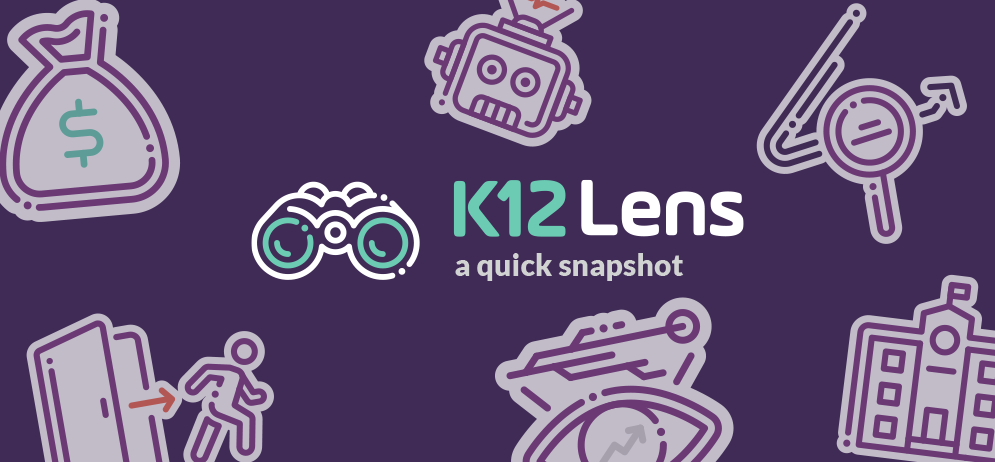As guardians of K-12 resources, district business leaders strive to ensure that K-12 schools have what they need to teach without interruption. However, in recent years, fiscal responsibility and district financial stability have grown increasingly complex, leading K-12 business leaders to question if their budgeting challenges are widespread, or unique to their districts and local economies.
This school year, Frontline’s Research and Learning Institute launched the K-12 lens, an annual survey that explores trends in district operations, like school funding availability and other factors impacting budgeting. Almost 700 K-12 employees, including business leaders, weighed in on important topics impacting the K-12 setting. This post leverages the data to provide a portrait of the K-12 business leader’s experience in the average district.
Less is the Norm
FROM THE K-12 LENS
Q: What is the most concerning barrier to student
success in your district?
A: Lack of funding and resources, meaning adequate staffing, materials, and time for planning.
Although districts have recently seen influxes in funding through waves of federal programs, when asked how school funding-related legislation has impacted their budgets in the past year, almost half of K-12 Lens respondents said that it has led to funding decreases. See the data in Figure 1, below.
Figure 1. Impact of Legislation on Available Funding
| It has led to significant decreases in our available funding | It has had minimal to no impact on our available funding | It has led to significant increases in our available funding |
| 45% | 31% | 24% |
Why Decreases Despite Federal Funding Surges?
Recent upticks in federal and state mandates have required districts to spend more. For instance, as of April 2024, 38 states and DC have passed “Science of Reading Laws.” These laws require districts to change the way they teach reading, which has led to a spending ripple effect. To comply, many districts have had to purchase new materials, pay for staff training, and in some cases create new positions to support teachers and students. The bottom line is that districts are having to shell out thousands of dollars to comply with this new law, which is just one of many.
The Top 3 Funding Concerns
The business leaders surveyed expressed concern over three major challenges impacting K-12 finances:
- Cybersecurity;
- Maintaining the tech assets currently in district, and;
- Budget forecasting to meet future tech needs. See the sections that follow.
#1 Cybersecurity
FROM THE K-12 LENS
Q: Explain what challenges exist to managing cyber risk.
A: We are doing pretty well with the basics, like making sure we have enough devices in hand and making sure those devices are working properly. The next level will require investment in money, resources, expertise and also a huge change in expectation of the staff and leadership of how the technology department works. Because the next level is such a jump we have been focusing one step at a time which, at times, is slower than we want to be.
The average school spends less than 8% of its IT budget on cybersecurity. However, with a 275% growth in cyber-attacks on K-12 organizations in 2023, many district business leaders are questioning that line item. Districts are often forced to spend more to recover from cyber-attacks than they would have spent upfront on prevention measures. Shutting down networks, recovering sensitive data, and strengthening weak systems to prevent future attacks are all costly. K-12 Lens respondents are aware of these associated costs, which is why cybersecurity topped the list of technology challenges and concerns, with almost two-thirds ranking it as their number one or two concern. See the data in Figure 2.
Figure 2. Ranked Tech Challenges and Concerns
#2 Technology Maintenance and Forecasting to Meet Future Tech Needs
Over half of K-12 business leaders (55%) indicated that maintaining current district technology is a top priority. In recent years, districts have made significant investments to enable 1:1 tech programs. According to an Edweek survey, by 2021, 90% of middle and high schools surveyed provided one digital device per student, marking a 31% increase from the previous year.
However, many of these devices, such as Chromebooks, were not designed for longevity and come with built-in expiration dates. Despite efforts to prolong their lifespan through software or hardware updates, some will inevitably stop working. A report form the U.S. Public Interest Research Group Education Fund claimed that the Chromebooks purchased by districts at that time had a projected four-year lifespan.
With these digital devices now deeply embedded in teaching and learning practices, K-12 business leaders face the challenge of ensuring their continued functionality or securing the funds to purchase replacements as their expiration dates draw near. Many lack confidence in their ability to do the latter. See below.
K-12 Business Leaders Are Least Confident in Ability to Forecast Budgets to Meet Future Technology Needs
#3 From Data to Action
Based on our findings, the average district business leader faces reduced funding and concerns about various tech challenges, notably cybersecurity, digital device maintenance, and budget forecasting for future technology needs. Be sure to check out the full K-12 Lens Survey Report for more insights that matter to K-12 business leaders, like enrollment and staffing trends.
Ellen Agnello
Ellen is a graduate assistant at the University of Connecticut. She is a former high school English language arts teacher and holds a Master’s Degree in literacy education. She is working on a dissertation toward a Ph.D. in Educational Curriculum and Instruction.
